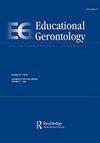确定使用智能手表监测老年人健康状况的障碍和促进因素
IF 1.5
4区 教育学
Q3 EDUCATION & EDUCATIONAL RESEARCH
引用次数: 0
摘要
智能手表是一种可穿戴设备,可以持续监测个人的活动和关键的健康指标。随着美国65岁以上老年人的数量持续增长,他们对智能手表的使用也在不断增加,因此有必要了解这些设备在现实世界中的使用情况,以监测健康状况。在这项研究中,研究人员为受教育程度和数字技能相对较高的老年人提供了一块配有移动应用程序(ROAMM)的智能手表,佩戴时间中位数为14天。分发可用性调查,并对参与者使用智能手表和ROAMM应用程序的体验进行定性分析。技术接受模型和实施研究统一框架的结构被纳入深度访谈,并被记录和转录。数据分析采用恒定比较法。对30名老年人的采访揭示了以下主题:1)对设备的熟悉和采用和接受;2)鼓励使用的因素,如医生的认可或跟踪健康状况的吸引力;3)使用障碍,如教育和培训不足以及对附加功能的渴望。总体而言,参与者发现智能手表易于使用,并可能在长期研究中继续使用该设备。智能手表产生的数据有可能让个人了解自己的健康状况,并可能激励他们在临床就诊时更积极地参与。披露声明作者未报告潜在的利益冲突。本研究得到了:佛罗里达大学Claude D Pepper老年美国人独立中心数据科学与应用技术核心[P30 AG028740]的支持。佛罗里达大学信息学研究所SEED基金和UF临床和转化科学研究所,该研究所由NIH国家促进转化科学中心部分支持,奖励号为[UL1 TR001427]。R21 AG059207的部分资金用于支持项目期间的教职员工;吉尔博士得到了耶鲁大学克劳德·d·佩珀美国老年人独立中心的部分支持。本文章由计算机程序翻译,如有差异,请以英文原文为准。
Identifying barriers and facilitators for using a smartwatch to monitor health among older adults
ABSTRACTSmartwatches are a type of wearable device that enable continuous monitoring of an individual’s activities and critical health metrics. As the number of older adults age 65+ continues to grow in the U.S. so does their usage of smartwatches, making it necessary to understand the real-world uptake and use of these devices to monitor health. In this study, older adults with a relatively high level of education and digital skills were provided with a smartwatch equipped with a mobile application (ROAMM) that was worn for a median of 14 days. Usability surveys were distributed, and a qualitative analysis was performed about participants’ experience using the smartwatch and ROAMM application. Constructs from the Technology Acceptance Model and Consolidated Framework for Implementation Research were incorporated into in-depth interviews, which were recorded and transcribed. Data were analyzed using the constant comparative method. Interviews among 30 older adults revealed the following main themes: 1) familiarization with the device and adoption and acceptance, 2) factors encouraging usage, such as a doctor’s endorsement or the appeal of tracking one’s health, and 3) barriers to usage, such as insufficient education and training and the desire for additional functionality. Overall, participants found the smartwatch easy to use and were likely to continue using the device in a long-term study. Data generated from smartwatches have the potential to engage individuals about their health and could inspire them to participate more actively during clinical encounters. Disclosure statementNo potential conflict of interest was reported by the author(s).Additional informationFundingThis work was supported by:The Data Science and Applied Technology Core of the Claude D Pepper Older Americans Independence Center at the University of Florida [P30 AG028740]. University of Florida Informatics Institute SEED Funds and the UF Clinical and Translational Science Institute, which is supported in part by the NIH National Center for Advancing Translational Sciences under award number [UL1 TR001427]. Partial funding from R21 AG059207 was used to support staff and faculty during the project; Dr. Gill was supported in part by the Yale Claude D. Pepper Older Americans Independence Center [P30AG021342].
求助全文
通过发布文献求助,成功后即可免费获取论文全文。
去求助
来源期刊

Educational Gerontology
Multiple-
CiteScore
2.50
自引率
13.30%
发文量
80
期刊介绍:
This well-respected journal offers up-to-date original research in the fields of gerontology, adult education, and the social and behavioral sciences. Researchers from around the world will benefit from the exchange of ideas for both the study and practice of educational gerontology. Papers published in the journal will also serve as authoritative contributions to the growing literature in this burgeoning field. Educational Gerontology is the only international journal of its kind to publish twelve issues per volume year. Articles featuring outcome-based practical educational resources in gerontology for the educational professional, care provider, trainer, and student in such areas as: art, music, drama and recreational therapies; mental health, communication arts, social programs and policies; and, social work, nursing, physical and occupational therapies, financial planners, architecture and interior design, family relations and therapy, and religion and spirituality.
 求助内容:
求助内容: 应助结果提醒方式:
应助结果提醒方式:


